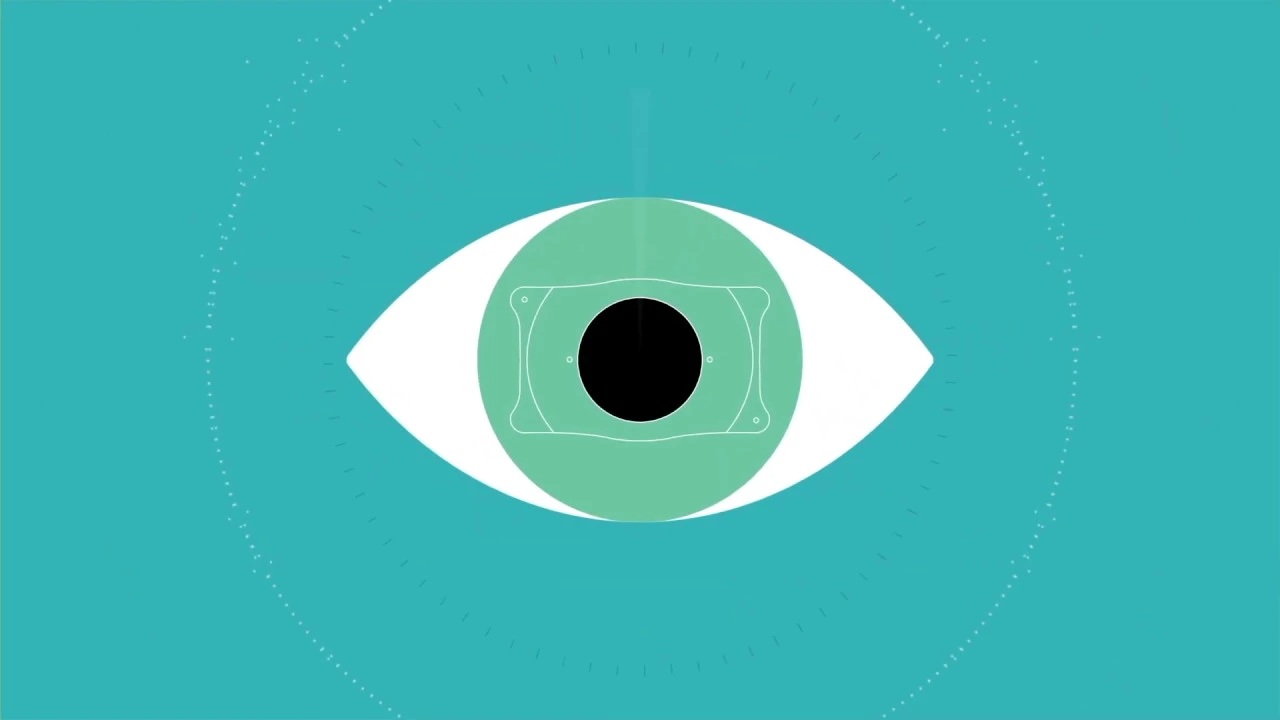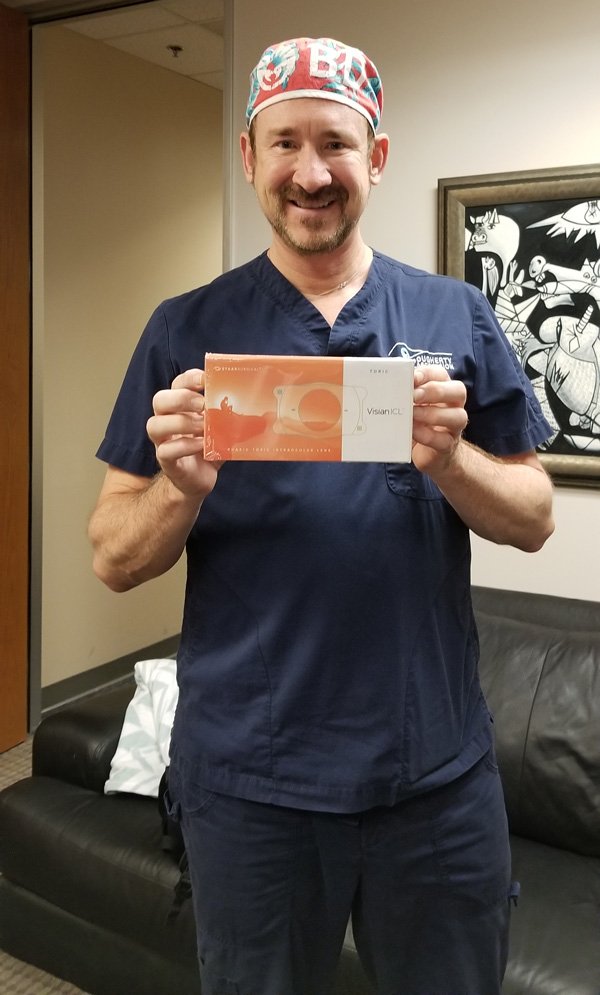Implantable Contact Lenses
Sub Title
Dougherty Laser Vision was the first vision correction center in the Western United States to offer the remarkable STAAR Visian ICL (Implantable Collamer Lens) for the treatment of mild to severe nearsightedness and the first surgeon in the U.S. to perform the Visian ICL procedure on both of a patient’s eyes during the same office visit.

What is the Visian ICL?
Approved by the FDA in December 2005, the Visian ICL is an implantable contact lens made of a biocompatible material called Collamer that allows the lens to be rolled into a tiny cylinder for insertion into the eye. As the ICL is inserted, it gently unfolds behind the iris, where it remains virtually undetectable to an observer. The Visian ICL is self-cleaning and needs no maintenance, unlike traditional contact lenses.
The Visian ICL can provide clear vision for nearsighted patients who demand a higher quality of vision than LASIK or who do not want a flap. Visian ICL is also an excellent option for patients who are not good candidates for LASIK due to thin or irregular corneas, dry eyes, or prescriptions that exceed the acceptable range for LASIK.

Did You Know?
- Dougherty Laser Vision is one of the first Visian ICL centers in the nation to offer the Sonomed UBM (ultrasound biomicroscopy), which measures the precise area for lens insertion to improve sizing of the lens.
- Dr. Dougherty helped pioneer the Visian ICL technology and was one of just a handful of surgeons in the U.S. to serve as a principal investigator for the Visian ICL FDA clinical study.
- In December 2005, Dougherty Laser Vision hosted the first post-approval ICL training session for U.S. ophthalmologists from across the nation and many continue to come to our centers to observe Dr. Dougherty performing the Visian ICL procedure.
- To date, Dr. Dougherty has performed over 4,000 ICL surgeries.
Why Visian ICL?
- Biocompatible Collamer maintains natural eye chemistry and won’t induce dry eye syndrome
- Permanent procedure, yet removable if vision needs change
- Quick procedure and recovery
- UV-blocking properties of the lens
- Can treat anywhere from a -3 diopter nearsightedness patient to a -20 diopter patient
- May be an ideal option for patients with thin or unusually shaped corneas
What Are the Benefits of the Visian ICL procedure?
The Visian ICL procedure benefits patients by reducing the surgery from four separate surgical procedures into a single surgical session and speeds up the visual recovery time so that the patient experience with Visian ICL implantation is just like LASIK. In fact, in our practice, we refer to the Visian ICL procedure as “LASIK with a lens.” Like LASIK, most patients have significantly improved vision the day after surgery with minimal discomfort and most patients are back to work or school within 48 hours.
Who Is a Good Candidate for Visian ICL?
- Have low, moderate, or extreme nearsightedness
- Have a stable prescription
- Are looking for a procedure that does not create dry eye
What If I Have Astigmatism?
The good news is that ICL lenses for astigmatism are available. How do you know if you have astigmatism? Usually, you’ll be unable to see near or distant objects clearly.
An implantable contact lens for astigmatism is inserted behind your eye’s lens. The ICL changes the way light rays bend as they enter your eye. With the lens implanted in place, refractive errors can be corrected, restoring your vision and eliminating signs of astigmatism.
ICL gives you clear vision without forcing you to wear glasses or insert, clean or remove contact lenses. Almost all patients who have undergone ICL surgery report complete satisfaction with their restored vision.
Some people with astigmatism worry about the level of pain or discomfort during and after the surgery. Because ICL astigmatism surgery doesn’t require any stitches to close the opening through which your ICL is inserted and your cornea heals on its own, your level of discomfort is likely to be very low.
As well, you will be given prescription eye drops, which will help to keep your eyes clean and infection-free, as well as reduce your discomfort even further. Your vision will improve immediately once the procedure is done, with no need to alter your cornea.
And, should your prescription change, your ICL can be removed and changed as needed. The lens is made from material that is compatible with the natural chemicals in your eyes. This means that you’ll experience dry eyes far less than those who have had other kinds of eye surgery.
If you’re a busy person, you will love the fact that ICL surgery will allow you to return to your regular activities far more quickly than other surgery types.
Of course, as with any surgery, ICL surgery does have some risks and side effects. These include over or under-correction as well as possible cataract surgery. Your eye surgeon will go over all of the risks and side effects with you during your consultation.
Frequently Asked Questions
What is Visian Toric ICL?
Visian Toric ICL is an implantable contact lens used to correct myopia (nearsightedness) and astigmatism. Visian Toric ICL can safely and effectively correct nearsightedness from -3 diopters up to -20 diopters along with treatment of astigmatism from 1 diopters to 4 diopters.
Receiving FDA approval in 2018, the Visian Toric ICL is a variant of the existing Visian ICL technology. The Visian Toric ICL has the same unique design as the original and can be implanted using the same personally developed technique created by Dr. Dougherty. The Visian Toric ICL is an appealing new treatment option for patients affected by both nearsightedness and astigmatism.
What is the ICL lens made of?
The ICL lens is made of Collamer, an advanced plastic lens material that is highly biocompatible. Collamer does not cause a reaction inside the eye and contains an ultraviolet filter that provides protection to the eyes.
Are ICLs different from contact lenses?
Yes. ICLs and contact lenses differ in a number of ways. Unlike contact lenses, ICLs don’t have to be removed or cleaned. Each time this occurs, you risk infecting and even damaging your eyes, especially if your lenses haven’t been cleaned, stored or inserted properly.
ICLs also mean no need to buy all the accessories for lens cleaning or storage. Where contact lenses must be inserted and removed once or more in a 24-hour period, ICLs remain behind your natural lens. Visit our comparison page for more differences between ICLs and contact lenses, differences between Visian ICL vs LASIK, Visian ICL cost, and much more.
How long do permanent contact lenses stay in my eye?
ICL is intended to remain in place in the eye without maintenance—it is self-cleaning. Should it become necessary, the lens can be removed by your surgeon later in life when you develop a cataract.
Will I be able to see the ICL in my eye?
No. The lens is positioned behind the iris where it is invisible to both you and observers. Only your doctor will be able to tell that vision correction has taken place.
Can the ICL be felt once it is in place?
ICL is placed behind the iris and in front of the eye’s crystalline lens. The lens does not touch any internal eye structures within your line of vision and is designed to stay in position, so you will not feel it.
How soon can I return back to my daily activities after having ICL surgery?
Most patients can return to their full daily routine activities the next day. However, we ask that you do not go swimming, bend past the waist or lift more than 20 pounds for 1 week after surgery.
Learn More About Contact Implant Surgery
Implantable contact lenses allow you to eliminate astigmatism symptoms without the need to make any changes to your eye, spend a long time in recovery, or risk damage or serious side effects.
At Dougherty Laser Vision, we promise our patients peace of mind. Book your consultation today by calling (805) 987-5300.

